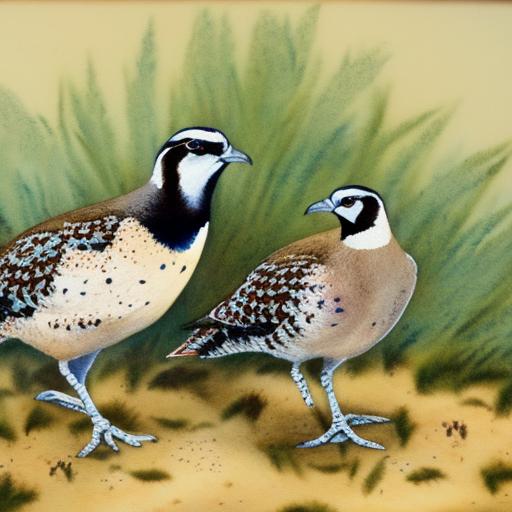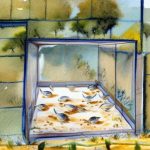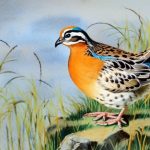The California quail, also known as the Valley quail, is a small ground-dwelling bird native to the western United States. The breeding season for California quail typically begins in late winter and extends through early summer, with peak activity occurring in the spring months. During this time, these birds engage in a variety of behaviors related to courtship, mating, nesting, and chick rearing. The breeding season is a critical time for the survival and success of the species, as it is when new generations of quail are produced to sustain the population. Understanding the various aspects of the California quail breeding season is essential for conservation efforts and management strategies to ensure the continued health and stability of their populations.
During the breeding season, male California quail become more vocal and active as they establish and defend territories to attract females. The females, on the other hand, become more selective in choosing a mate and a suitable nesting site. Once paired, the birds engage in courtship displays and rituals to strengthen their bond and prepare for the nesting phase. As the breeding season progresses, the focus shifts to egg laying, incubation, and parental care. Throughout this period, the quail face numerous challenges and threats that can impact their reproductive success. Conservation efforts and management practices play a crucial role in mitigating these challenges and ensuring the survival of California quail populations.
Key Takeaways
- California quail breeding season typically occurs in the spring and early summer.
- Quail prefer to nest in areas with dense vegetation and good ground cover for protection.
- Courtship and mating rituals involve elaborate displays and calls by the males to attract females.
- Female quail lay around 12-16 eggs and are responsible for incubating them for about 3 weeks.
- Both male and female quail play a role in caring for and protecting the chicks after hatching.
Nesting Behavior and Habitat Selection
Nesting behavior and habitat selection are crucial aspects of the California quail breeding season. Female quail are responsible for selecting a suitable nesting site, typically on the ground in areas with dense vegetation or shrub cover. The nest is a shallow depression lined with grass, leaves, and feathers, providing a secure and insulated environment for the eggs. The female quail carefully chooses the location of the nest to minimize the risk of predation and disturbance, often selecting areas with good visibility and easy access to food and water. Once the nest site is chosen, the female begins laying eggs, typically producing a clutch of 12-16 eggs over a period of several days.
Male quail play a supportive role in nesting behavior by guarding the nesting area and alerting the female to potential threats. They also engage in distraction displays to draw predators away from the nest, contributing to the overall protection of the eggs and chicks. The selection of suitable nesting habitat is critical for the survival of California quail populations, as it directly impacts their reproductive success. Loss of habitat due to urbanization, agriculture, and other human activities can significantly reduce available nesting sites and increase vulnerability to predation. Conservation efforts aimed at preserving and restoring suitable habitat are essential for maintaining healthy quail populations during the breeding season and beyond.
Courtship and Mating Rituals
Courtship and mating rituals are integral components of the California quail breeding season. Male quail engage in elaborate displays to attract females and establish their dominance within a territory. These displays often involve vocalizations, such as distinctive calls and crowing, as well as physical behaviors like strutting, head-bobbing, and wing-fluttering. These displays serve to communicate the male’s fitness and suitability as a mate, while also signaling his ability to defend a territory and provide protection for the female and potential offspring.
Female quail are actively involved in the courtship process, assessing the displays of potential mates and choosing partners based on their vigor and quality of displays. Once a pair bond is formed, the birds engage in mutual preening and other affiliative behaviors to strengthen their bond. Mating typically occurs within the established territory, with both male and female quail contributing to the reproductive process. Courtship and mating rituals are essential for successful reproduction in California quail, as they facilitate pair bonding and ensure genetic diversity within the population. Understanding these behaviors is crucial for conservation efforts aimed at preserving healthy breeding populations of California quail.
Egg Laying and Incubation
Egg laying and incubation are critical stages of the California quail breeding season, marking the transition from courtship and mating to parental care. Once a female has selected a nesting site and formed a pair bond with a male, she begins laying eggs at a rate of one per day until she has completed her clutch. The eggs are typically small and speckled, providing camouflage within their nesting environment. After all eggs have been laid, the female begins incubating them, using her body heat to maintain a consistent temperature for proper development.
Incubation typically lasts around 21 days, during which time the female rarely leaves the nest except for brief periods to feed and drink. The male continues to guard the nesting area and provide vocal warnings of potential threats, while also foraging for food to sustain both himself and the incubating female. Incubation is a critical period for the survival of the developing embryos, as any disturbance or interruption can have detrimental effects on their viability. Conservation efforts aimed at protecting nesting sites and minimizing human disturbance are essential for ensuring successful incubation and hatching of California quail eggs.
Parental Care and Chick Rearing
Parental care and chick rearing are essential components of the California quail breeding season, marking the transition from egg incubation to the raising of young offspring. Once the eggs hatch, both male and female quail take on active roles in caring for their chicks. The precocial nature of quail chicks allows them to leave the nest shortly after hatching, following their parents in search of food and shelter. The adults provide protection, guidance, and food for their young, teaching them essential skills for survival in their environment.
Parental care continues throughout the early stages of chick development, with both male and female quail contributing to feeding, protection, and socialization of their offspring. The adults lead their chicks to suitable foraging areas, teaching them to identify and consume a variety of seeds, insects, and vegetation. As the chicks grow, they become increasingly independent but continue to benefit from parental guidance and support. Conservation efforts aimed at preserving suitable habitat for chick rearing are essential for ensuring the survival of young California quail during this critical stage of development.
Challenges and Threats during Breeding Season

The California quail breeding season is fraught with numerous challenges and threats that can impact reproductive success and population stability. Loss of suitable habitat due to urbanization, agriculture, and other human activities is a significant threat to nesting sites and foraging areas for quail. Predation by mammals, birds of prey, and domestic pets poses a constant risk to eggs, chicks, and adult quail during the breeding season. Additionally, environmental factors such as extreme weather events, drought, and disease outbreaks can further impact reproductive success and chick survival.
Human disturbance from recreational activities such as off-road vehicles, hiking, and camping can disrupt nesting sites and cause stress to breeding quail populations. Pesticide use in agricultural areas can also have detrimental effects on quail reproductive success by reducing food availability and causing direct harm to adult birds and their offspring. Understanding these challenges is essential for implementing effective conservation efforts aimed at mitigating threats to California quail populations during the breeding season.
Conservation Efforts and Management of California Quail Breeding Season
Conservation efforts aimed at preserving healthy populations of California quail during the breeding season are essential for ensuring their long-term survival. Habitat preservation and restoration play a crucial role in providing suitable nesting sites, foraging areas, and protective cover for breeding quail populations. Land management practices that prioritize habitat conservation can help minimize human disturbance and reduce the impact of urbanization on quail populations.
Education and outreach programs aimed at raising awareness about the importance of conserving California quail populations can help garner support for conservation efforts among local communities. Monitoring programs that track population trends, reproductive success, and habitat quality provide valuable data for assessing the effectiveness of conservation measures and identifying areas in need of additional protection.
Collaborative partnerships between government agencies, conservation organizations, landowners, and local communities are essential for implementing comprehensive management strategies that address threats to California quail populations during the breeding season. By working together to preserve suitable habitat, minimize human disturbance, and mitigate threats from predation and environmental factors, stakeholders can help ensure that future generations will continue to enjoy the presence of these iconic birds in their natural habitats.
During the California quail breeding season, it’s essential to provide a suitable environment for these birds to thrive. If you’re considering raising quail, you may also be interested in learning about the best practices for setting up a chicken coop. Poultry Wizard offers valuable insights on where to put a chicken coop, which can be crucial for creating an optimal breeding environment for various poultry species. Check out their article on where to put a chicken coop to ensure that your quail and other poultry have the ideal living space for successful breeding.
FAQs
What is the breeding season for California quail?
The breeding season for California quail typically occurs from late April to early August.
How do California quail prepare for breeding season?
During the breeding season, male California quail will establish territories and perform courtship displays to attract females. They will also engage in aggressive behaviors to defend their territory.
How many eggs do California quail lay during the breeding season?
Female California quail can lay up to 12 eggs in a single clutch during the breeding season.
Where do California quail build their nests during the breeding season?
California quail typically build their nests on the ground, often in a shallow depression lined with grass and feathers for insulation.
How long does the breeding season last for California quail?
The breeding season for California quail usually lasts for about 3-4 months, from late spring to early summer.
Meet Walter, the feathered-friend fanatic of Florida! Nestled in the sunshine state, Walter struts through life with his feathered companions, clucking his way to happiness. With a coop that’s fancier than a five-star hotel, he’s the Don Juan of the chicken world. When he’s not teaching his hens to do the cha-cha, you’ll find him in a heated debate with his prized rooster, Sir Clucks-a-Lot. Walter’s poultry passion is no yolk; he’s the sunny-side-up guy you never knew you needed in your flock of friends!







